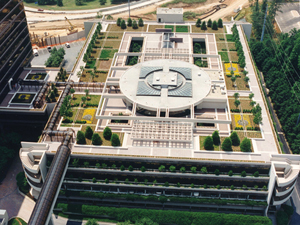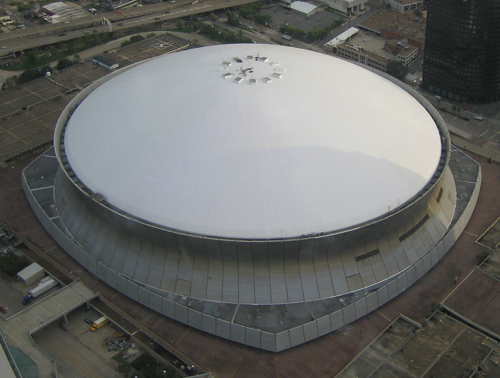Sustainable Roofing Strategies
LEED® AND ENERGY PROGRAMS
The U.S. Green Building Council's Green Building Rating System, Leadership in Energy and Environmental Design (LEED®), is a voluntary certification program for sustainable buildings. LEED for New Construction and Major Renovations (LEED-NC) Version 2.2 allows credit for several roofing types and related strategies.
Â
Green roofs can contribute up to 14 credits with LEED-NC, Version 2.2. Between one and two points can be earned in the following categories: Storm Water Management, Landscape and Exterior Design to Reduce Heat Islands, Recycled Content, Reduced Site Disturbance, Water Efficient Landscaping, Local/Regional Materials, and Optimized Energy Performance. Typically, plant choices for green roofs are native to the area, and the growing media is locally sourced, so that soil is not shipped far.
Cool roofs can receive credits under LEED-NC Version 2.2, Sustainable Site Credit 7.2; Heat Island Effect: Roof. LEED-NC credits roofs with an SRI value greater than or equal to 78 for low-slope roofs, and 29 for steep-slope roofs. LEED for Existing Buildings (LEED-EB) Version 2.0 provides credit for a cool roof under Sustainable Site Credit 6.2: Heat Island Reduction: Roof.
Various energy codes, green building initiatives, and public agencies have adopted cool roof measures. Several electrical utilities offer rebates for installation of cool roofing materials in new construction or major roof retrofits, as incentives to save energy and reduce peak demand. As of 2007, utility rebate programs include Pacific Gas & Electric Company, Southern California Edison, Idaho Power, and the City of Austin.
 |
North Park 400, Atlanta, GA. This accessible public green roof is a popular gathering
place. Architect: Thompson, Ventulett, Stainback & Associates. |
Two building industry organizations, the International Code Council (ICC) and the American Society of Heating, Refrigerating and Air-Conditioning Engineers (ASHRAE) have developed National Model Energy Codes. These documents are not mandatory or enforceable until a jurisdiction adopts them. In the U.S., many states and jurisdictions have adopted these organizations' codes, while California and the City of Chicago have developed their own.
The California Energy Commission's Building Energy Efficiency Standard, Title 24 includes a cool roof prescription for low-sloped (less than 2:12) nonresidential roofs for new construction and major re-roofing, and requires that cool roofs be tested and labeled by a third-party rating program. Title 24 defines a cool roof as any roofing product with an initial thermal emittance greater than or equal to 0.75 and a minimum initial solar reflectance of 0.70. Title 24 makes limited exceptions for clay and concrete tiles and products with low thermal emittance and comparatively high solar reflectance.
Â
Cool roofs are not mandatory under Title 24. Nonresidential buildings with low-sloped roofs can comply by choosing one of the available compliance options, regarding performance, envelope component or overall envelope approach.
The City of Chicago's Energy Conservation Code includes a requirement for cool roofs as a way to mitigate the urban heat island effect. Chicago requires cool roofs in low-sloped roofing applications. Roofs installed before December 31, 2008 must meet a minimum solar reflectance of 0.25 for initial and aged values. After that date, roofing products must meet ENERGY STAR criteria.
Asphalt Roof Disposal
Older roofs use up natural resources, such as asphalt and oil-based components for installation, tear-offs, disposal, and reroofing. Upgrading existing roofs can utilize existing components, such as insulation, if total roof replacement isn't needed. With carefully chosen materials and installation, high-performance, low-maintenance systems can restore original performance levels to existing roofs, and minimize deterioration over time.
Asphalt roofs with coal tar pitch and gravel surfaces are typical of tear-offs that are disposed in landfills. According to the Asphalt Roofing Manufacturing Association, two million tons of asphalt coated membrane roofing has been sent to the waste stream, representing 11 million tons of roofing waste per year, and seven to 10 percent of landfill space over the last 40 years.
Used or Salvaged Slate Roofs
For older roofs, problems with flashing or other deteriorating components may necessitate partial or major roofing replacements. A used or salvaged slate roof is one in which the designer or owner has chosen to reuse slate that has already been installed on a roof, such as for reduced material costs. The aesthetic appeal of an aged roof, with colors unlikely to change, and the interest in retaining historic materials may be considerations. All slate ages differently, so used slate should be evaluated carefully, since salvaged slate may come from several sources.
Reuse of salvaged slate roofs may qualify for one point under LEED-NC for New Construction and Major Renovations, Version 2.2, Materials and Resources. Credits 3.1 and 3.2 offer one point each for Materials Reuse, based on five or ten percent, respectively, of total project material costs.
|
||
Â
The intent of MR Credit 3.1 Materials Reuse, Five Percent, is to reuse building materials and products to reduce demand for virgin materials and reduce waste, thereby reducing impacts associated with the extraction and processing of virgin resources. The requirements call for salvaged or reused materials, so that the sum of these materials constitutes at least five percent, based on cost, of the total value of materials on the project. MR Credit 3.2: Materials Reuse: Ten Percent, is similar to Credit 3.1, based on ten percent of the total value of project materials.
CASE STUDY: NEW ORLEANS SUPERDOME
Foam roofing systems with proper coatings perform in adverse conditions, such as hurricane-force winds and steady rain. After Hurricane Katrina in 2005, the New Orleans Superdome was severely damaged by high winds which lifted the bladder-like covering and rivets off the structure, creating a vacuum that left holes in the roof. The damage was extensive, down to the steel deck.
Special coatings, which fully adhered to the roof surface, fixed the problem. The damage was further repaired using metal covered with foam, and topped with coatings to protect the roof with a seamless system. The membrane was added to the large opening at the top of the Superdome, primed, and topped with a spray coating, providing superior wind uplift resistance. The New Orleans Superdome replacement was completed in record time. Damaged areas below the dome were recoated with a fluid-applied coating system and spray polyurethane foam. This high-performance design solution has proven to be very effective for coastal areas prone to hurricane conditions, especially along the Gulf Coast, from Biloxi to New Orleans.
SUMMARY
Energy conservation and energy cost reductions have become primary concerns to building owners, architects, and building industry professionals, as well as American mayors and public officials concerned about the environment. Raising public awareness about the urban heat island effect, and ways to mitigate its negative impact, remain increasingly important for all those who live and work in cities, and rely on thriving urban environments to enhance the quality of life.
Â
Sustainable roofing design strategies have taken on greater importance in recent years. Owners and architects have many sustainable roofing options to choose from, whether for new construction, major renovation, or reroofing projects. The growing interest in cool roofs has lead to renewed interest in green, or garden, roofs; white roofs, foam roofs with special coatings, and slate roofs. These varied approaches are among









